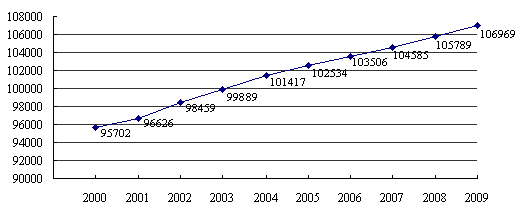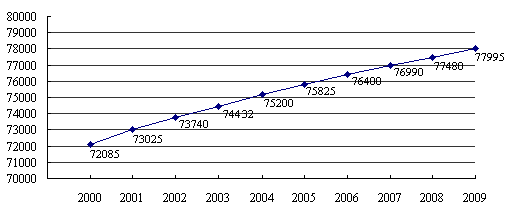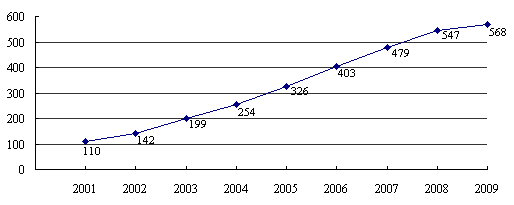I. The Basic Situation of China's Human Resources
A large population and rich human resources constitute the basic national situation of China. For years, the Chinese government has pursued proactive and effective policies and measures to enhance the development and utilization of human resources, bringing about re-markable changes in this field.
Human resources growing in scale. By the end of 2009 China's total population had reached 1.33474 billion (excluding that of the Hong Kong and Macao Special Administrative Regions and Taiwan Province), which contains a labor force of 1.06969 billion persons, 112.67 million more than in 2000; the number of employees had reached 779.95 million, of whom 311.2 million were urban employees, increases of 59.1 million and 79.69 million, respectively, compared with the year 2000.
 |
| Chart 1 Changes in Labor Force (2000-2009) (Unit: 10,000 people)? |
 |
| ?Chart 2 Changes in the Number of Employees in Urban and Rural Areas (2000-2009) (Unit: 10,000 people) |
Remarkable improvement of education. China gives priority to education in its development strategy, and has established a com-paratively complete national modern educational system. In 2000 Nine-Year Compulsory Education was made universal throughout the country, and illiteracy among people between the ages of 20 and 50 was basically eliminated. The number of teenagers attending senior middle school has increased greatly; vocational education has been especially enhanced; and higher education is becoming more popular. In 2009 the total number of senior middle school students in China amounted to 24.3428 million; students at various secondary vocational schools numbered 21.9516 million; undergraduates studying at all sorts of universities and colleges numbered 21.4466 million and postgradu-ate students 1.4049 million. The development of national education has remarkably raised employees' educational level. By the end of 2009, the average schooling of people above 15 years old had reached nearly 8.9 years, while that of the majority of the working population was 9.5 years, of which 9.9% had received higher education. The average edu-cation time of newly increased labor force amounted to 12.4 years.
 |
| ?Chart 3 Changes in the Number of University and College Graduates (2001-2009) (Unit: 10,000 people) |
Optimized employment structure. With China's economic de-velopment and industrial structure adjustment, the proportion of those employed in primary industry has dropped significantly while that in tertiary industry has risen greatly. In 2009 the proportion of employ-ment in primary, secondary and tertiary industries changed to 38.1%, 27.8%, and 34.1% from 50%, 22.5% and 27.5%, respectively in 2000.
 |
| Chart 4 Changes in the Employment Structure of Primary, Secondary and Tertiary Industries (2000-2009)? |
Good progress in talent development.
People having professional knowledge or special skills who con-tribute to society through creative work are highly regarded in China. They are a high-ability and high-quality labor force among human re-sources. The Chinese government has drawn up and implemented a se-ries of major principles and policies to advance the building of contingents of people of all kinds for the Party and government, enter-prise operation and management, professional techniques, high tech-nology, rural affairs and social work in an all-round way. Through years of efforts, the number of talented people has maintained a stable increase, with improved quality, optimized structure and gradually ris-ing utilization efficiency. By the end of 2008 the total number of such people in China had reached 114 million.
Gradual improvement of income, health care and social se-curity as guarantees for human resources development.
With the country's sustained and rapid socioeconomic develop-ment, the income of urban and rural residents has maintained a stable growth. The average disposable income of urban residents increased from less than RMB 100 yuan in 1949 to 15,781 yuan in 2008; and the average net income of rural residents increased from RMB 44 yuan in 1949 to 4,761 yuan in 2008. Great efforts have been mobilized to build up the public health system so as to provide guarantee for improving the health of people nationwide. By the end of 2009 there were 289,000 medical institutions nationwide, 5.22 million medical workers and 3.96 million hospital beds in total. In recent years, the Chinese government has vigorously accelerated the building of the social secu-rity system to cover rural and urban residents and to provide basic life assurance for each individual. In 2009, urban basic retirement insur-ance covered 235.5 million people; the total number of urban employ-ees covered by basic medical insurance, urban residents covered by basic medical insurance and people in the countryside covered by the new rural cooperative medical insurance reached 1.2 billion; unemployment insurance, work-related injury insurance and maternity insurance covered 127.15 million, 148.96 million and 108.76 million people, respectively. China implements a subsistence allowance sys-tem. By the end of 2009, 23.477 million urban residents and 47.593 million rural residents had enjoyed subsistence allowances from the government. China has implemented planned and organized large-scale poverty relief programs throughout the country. In 2009, the rural population living in poverty was reduced to 35.97 million, with the nationwide poverty rate dropping to 3.6%.